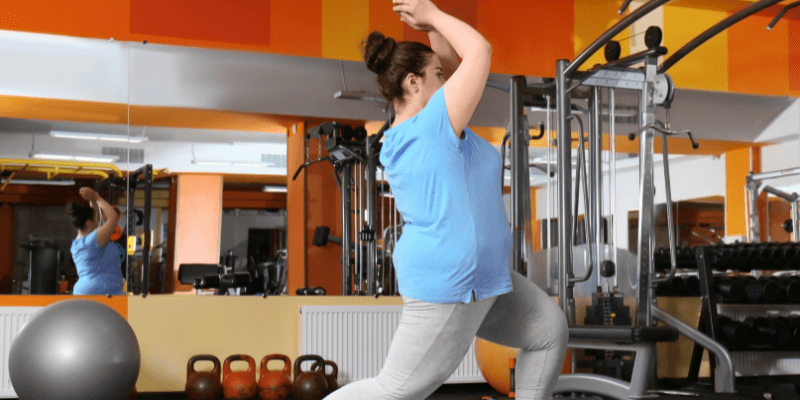Are hiit workout for obese beginners an effective workout plan?
Losing weight and improving your health is easy with High-Intensity Interval Training (HIIT).
HIIT combines short, intense bursts of exercise with periods of rest, making it a highly efficient way to burn fat and build muscle.
In this article, we will provide you with a comprehensive guide on HIIT workouts for obese beginners.
What is HIIT?

HIIT is a type of cardiovascular exercise that alternates between intense bursts of activity and periods of rest.
This type of workout is designed to increase your heart rate and improve your overall fitness level.
Many exercises, like jogging, cycling, jumping jacks, and burpees, can be included in HIIT workouts.
Benefits of HIIT Workouts for Obese Beginners
HIIT workouts are highly effective for obese beginners for a number of reasons.
Here are some of the benefits of incorporating HIIT workouts into your fitness routine:
1. Burn Fat
HIIT workouts are highly effective for burning fat because they increase your metabolism and keep your body burning calories long after the workout is over.
2. Build Muscle
HIIT workouts are also great for building muscle because they require you to perform high-intensity exercises that challenge your body.
3. Improve Cardiovascular Health
HIIT workouts can improve your cardiovascular health by increasing your heart rate and improving your oxygen intake.
4. Save Time
HIIT workouts are time-efficient because they can be completed in as little as 20-30 minutes.
- Related: HIIT for beginners weight loss!
What are some simple HIIT workouts suitable for beginners who are obese?
A well-liked exercise method called high-intensity interval training (HIIT) combines short bursts of intense exercise followed by rest intervals.
In terms of difficulty level and speed, HIIT workouts can be an excellent option for beginners who are obese.
Ensure that obese beginners start at an appropriate fitness level before starting any new exercise program.
A simple HIIT workout for beginners who are obese could include a warm-up period of 5-10 minutes of light cardio exercise, such as walking or cycling, followed by the following exercises:
- Bodyweight squats: Perform 10-12 repetitions, rest for 30 seconds, and repeat for a total of 3-4 sets.
- Modified push-ups: Perform 8-10 repetitions, rest for 30 seconds, and repeat for a total of 3-4 sets.
- Step-ups: Step up onto a bench or step platform, perform 10-12 repetitions with each leg, rest for 30 seconds, and repeat for a total of 3-4 sets.
- Jumping jacks: Perform 20-30 repetitions, rest for 30 seconds, and repeat for a total of 3-4 sets.
- Plank hold: Hold a plank position for 20-30 seconds, rest for 30 seconds, and repeat for a total of 3-4 sets.
- Cool down with 5-10 minutes of light cardio exercise and stretching.
In summary, simple HIIT workouts can be a great option for beginners who are obese. Starting at an appropriate fitness level, incorporating bodyweight exercises, and gradually increasing the intensity and duration of the workout can help beginners build strength and endurance while avoiding injury.
How to Get Started with HIIT Workouts
If you are an obese beginner, it is important to start slowly and gradually increase the intensity of your workouts. Here are some tips to help you get started with HIIT workouts:
1. Consult with Your Doctor
Before starting any new workout program, it is important to consult with your doctor to ensure that it is safe for you to exercise.
2. Choose the Right Exercises
Choose exercises that are low-impact and do not put too much strain on your joints. Some good options include walking, cycling, and swimming.
3. Start Slowly
Start with short, low-intensity workouts and gradually increase the intensity and duration of your workouts over time.
4. Listen to Your Body
When working out, pay attention to how your body feels both during and after. If you experience pain or discomfort, reduce the intensity of your workouts.
- Related: Hiit for weight loss!
Is HIIT appropriate for individuals who are obese?
In addition to its numerous health benefits, HIIT workouts can also be a time-efficient way for obese individuals to fit exercise into their busy schedules.
- HIIT workouts can be a safe and effective form of exercise for obese individuals looking to improve their health and fitness.
- HIIT can improve body composition, blood pressure, insulin sensitivity, and cardiovascular health in obese individuals.
- Low-impact exercises can be incorporated into HIIT workouts to reduce joint stress for obese individuals.
- HIIT workouts can be time-efficient, allowing obese individuals to fit exercise into their busy schedules.
- Obese individuals should consult with a healthcare professional before starting a new exercise program, including HIIT workouts.
- Reduce the risk of injury by gradually increasing the intensity and duration of HIIT workouts.
Sample HIIT Workout for Obese Beginners
Here is a sample HIIT workout that is perfect for obese beginners:
Warm-up
- 5-minute walk or low-impact cardio exercise
Workout
- 30 seconds of high-intensity exercise (such as jumping jacks or squats)
- 60 seconds of low-intensity exercise (such as walking or marching in place)
- Repeat for a total of 10 rounds
Cool-down
- 5-minute walk or low-impact cardio exercise
Which type of HIIT workout is most effective for fat loss?
High-intensity interval training (HIIT) has become increasingly popular in recent years due to its effectiveness in improving fitness and promoting weight loss.
Research has shown that HIIT can lead to greater fat loss compared to steady-state cardio workouts.
However, not all types of HIIT are created equal when it comes to fat loss.
Some types of HIIT may be more effective than others for promoting weight loss and reducing body fat.
- One type of HIIT that has been shown to be particularly effective for fat loss is sprint interval training (SIT).
- SIT involves short bursts of maximal effort sprinting followed by brief periods of rest or low-intensity activity.
- Bodyweight HIIT workouts, circuit training, and Tabata-style workouts are also effective for fat loss.
- The most effective type of HIIT for fat loss will vary depending on individual factors such as fitness level, preferences, and goals.
- Individuals should consult with a healthcare professional before beginning any exercise program, including HIIT workouts.
- Gradually increasing the intensity and duration of HIIT workouts is important for reducing the risk of injury and achieving long-term fitness goals.
- Combining HIIT workouts with a healthy diet and lifestyle can lead to even greater fat loss and overall health improvements.
A study published in the Journal of Obesity found that overweight individuals who participated in a SIT program experienced greater fat loss and improvements in cardiovascular health compared to those who did moderate-intensity continuous training (MICT).
FAQs: HIIT Workout for Obese Beginners
1.Can obese beginners do HIIT workouts?
Yes, obese beginners can do HIIT workouts as long as they start slowly and gradually increase the intensity of their workouts.
2.How often should I do HIIT workouts?
You should aim to do HIIT workouts 2-3 times per week, with rest days in between.
3. Can HIIT workouts be modified for those with limited mobility?
Yes, HIIT workouts can be modified for those with limited mobility. You can choose exercises that are low-impact and do not put too much strain on your joints, such as cycling or swimming. You can also adjust the intensity and duration of your workouts to suit your needs.
4.Can HIIT workouts be done at home?
Absolutely, and requiring little to no equipment, HIIT exercises may be performed at home. Bodyweight exercises such as squats, lunges, and push-ups are great for HIIT workouts. You can also incorporate household items such as water bottles or chairs into your workouts. Remember, it is important to start slowly and gradually increase the intensity and duration of your workouts over time. With dedication and consistency, you can achieve your fitness goals and improve your overall health with HIIT workouts.
5.How often should I do HIIT workouts?
The frequency of your HIIT workouts will depend on your fitness level and goals. For beginners, it is recommended to start with 1-2 HIIT workouts per week and gradually increase the frequency as your fitness improves. It is also important to give your body time to rest and recover between workouts to avoid injury and burnout. Incorporating other forms of exercise such as strength training and low-impact cardio can also help to balance out your workout routine.
Final thoughts
HIIT workouts are a highly effective way for obese beginners to lose weight and improve their overall health.
By starting slowly and gradually increasing the intensity of your workouts, you can achieve your fitness goals while minimizing the risk of injury.
Remember to consult with your doctor before starting any new workout program and always listen to your body.
Cheers!
